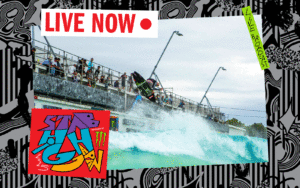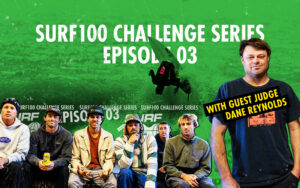The Shark Solution – Shark Summit in Australia
The desperately needed Shark Summit is underway as of typing at Sydney’s Taronga Zoo. It’s been a long time coming: Attacks and sightings have reached unprecedented levels along Australia’s east and west coasts in recent years, with paranoia perpetuated by the social media age. Today’s summit, in which the NSW State government will draw on evidence provided by dozens of scientists from around the world, will provide a way forward for both Australian and international surfing communities. In a classically Australian scenario, the man behind the summit, NSW Premiere Mike Baird, narrowly avoided being attacked himself while surfing Crescent Head. The four solutions being discussed at today’s summit are: 1. Physical and visual barriers. We’re talking shark nets here, though a modern version of the clumsy prototypes that too often snagged dolphins, turtles and other plus-sized piscatorials. The Eco Barrier is among the companies being considered. It offers a net made of “strong, flexible nylon” that lasts up to 10 years and provides a completely enclosed swimming area from seabed to surface, and shoreline to shoreline. The semi-rigid plastic “net” is designed to act as a wall to sea life without the danger of entanglement. 2. Electric deterrent barriers. Belgian company Aquatek provides a repelling system that disrupts a sharks electroreceptive sense by blasting water with a magnetic field. Already trialled over a four year period – including trials at Reunion Island, the scene of an unprecedented shark plague in recent years – Aquatek uses fish finder technologies to target particular species of marine life, including sharks. It works via a series of floating posts which put out an electro-magnetic field. The posts can also be used to support nets as a backup in case the sharks flee in the wrong direction. 3. Satellite and acoustic technology. Although there is no specific company listed, it is hoped 4G technology can be used to transmit shark movements in real time back to a base which in turn can be used to alert the appropriate authorities. The CSIRO and NSW Department of Primary Industries are already tagging great white sharks along the North Coast of NSW where 12 attacks in 12 months, including 2 fatalities, has seen shark hysteria grip the region. 4. Sonar technologies. Billed as the world’s first shark detection buoy, the Clever Buoy, which is being developed by telco giant Optus, sends sonar alerts to a satellite and a text message to lifeguards on the beach when it detects a moving shark. Previously trialled in the former fatal-shark attack capital of the world, Western Australia, the yellow buoy is able to identify the signature sonar data of a shark and relay the information in real-time. Findings from the Summit will be released within the next week. Stay tuned.
The desperately needed Shark Summit is underway as of typing at Sydney’s Taronga Zoo. It’s been a long time coming: Attacks and sightings have reached unprecedented levels along Australia’s east and west coasts in recent years, with paranoia perpetuated by the social media age. Today’s summit, in which the NSW State government will draw on evidence provided by dozens of scientists from around the world, will provide a way forward for both Australian and international surfing communities. In a classically Australian scenario, the man behind the summit, NSW Premiere Mike Baird, narrowly avoided being attacked himself while surfing Crescent Head. The four solutions being discussed at today’s summit are:
1. Physical and visual barriers. We’re talking shark nets here, though a modern version of the clumsy prototypes that too often snagged dolphins, turtles and other plus-sized piscatorials. The Eco Barrier is among the companies being considered. It offers a net made of “strong, flexible nylon” that lasts up to 10 years and provides a completely enclosed swimming area from seabed to surface, and shoreline to shoreline. The semi-rigid plastic “net” is designed to act as a wall to sea life without the danger of entanglement.
2. Electric deterrent barriers. Belgian company Aquatek provides a repelling system that disrupts a sharks electroreceptive sense by blasting water with a magnetic field. Already trialled over a four year period – including trials at Reunion Island, the scene of an unprecedented shark plague in recent years – Aquatek uses fish finder technologies to target particular species of marine life, including sharks. It works via a series of floating posts which put out an electro-magnetic field. The posts can also be used to support nets as a backup in case the sharks flee in the wrong direction.
3. Satellite and acoustic technology. Although there is no specific company listed, it is hoped 4G technology can be used to transmit shark movements in real time back to a base which in turn can be used to alert the appropriate authorities. The CSIRO and NSW Department of Primary Industries are already tagging great white sharks along the North Coast of NSW where 12 attacks in 12 months, including 2 fatalities, has seen shark hysteria grip the region.
4. Sonar technologies. Billed as the world’s first shark detection buoy, the Clever Buoy, which is being developed by telco giant Optus, sends sonar alerts to a satellite and a text message to lifeguards on the beach when it detects a moving shark. Previously trialled in the former fatal-shark attack capital of the world, Western Australia, the yellow buoy is able to identify the signature sonar data of a shark and relay the information in real-time.
Findings from the Summit will be released within the next week. Stay tuned.













Comments
Comments are a Stab Premium feature. Gotta join to talk shop.
Already a member? Sign In
Want to join? Sign Up